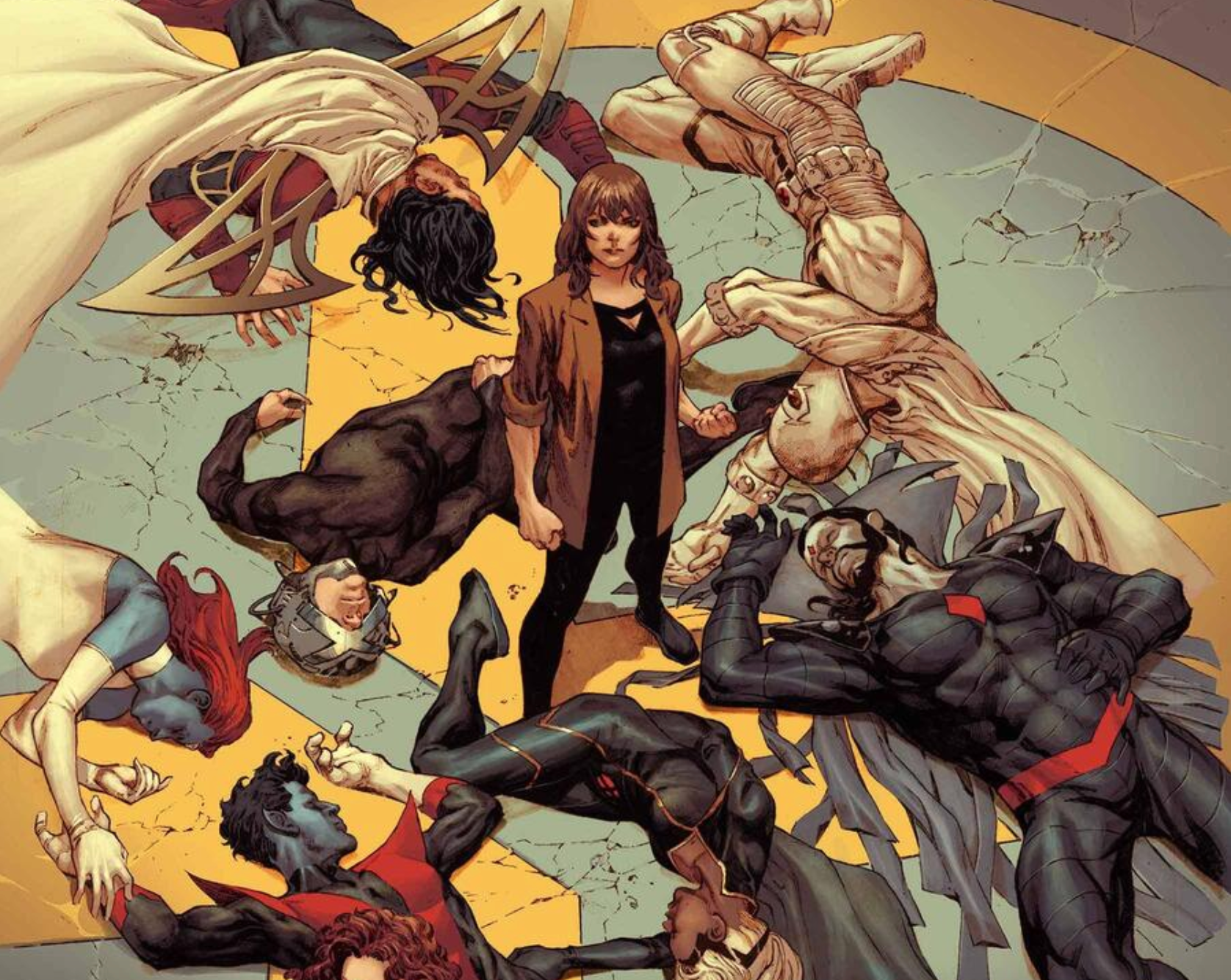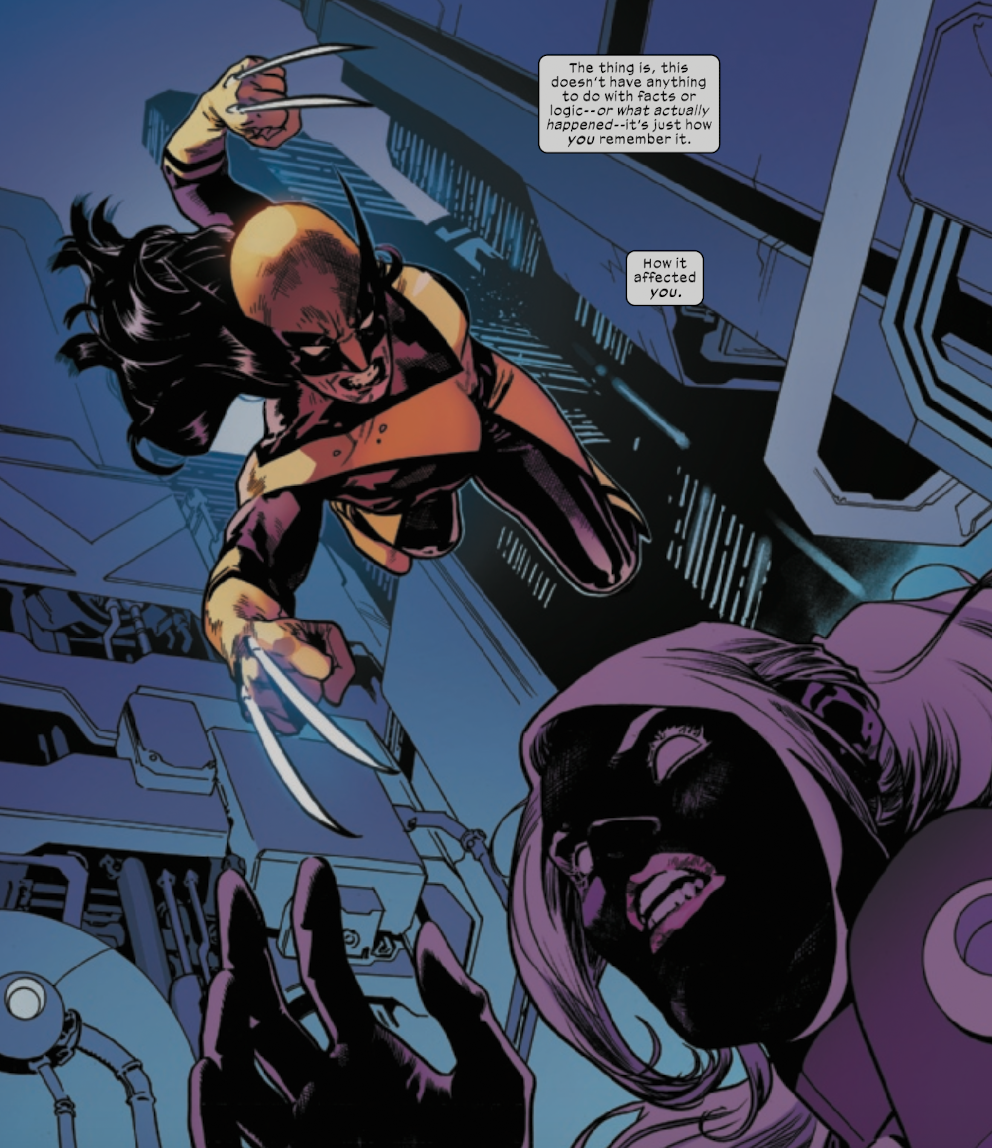The Mutants Always Win
Inferno #3
Written by Jonathan Hickman
Art by R.B. Silva with Valerio Schiti and Stefano Caselli
Color art by David Curiel
“The mutants ALWAYS WIN.”
That’s the line that made me audibly gasp. The revelation that the Omega Sentinel we’ve been seeing since House of X #1 is not quite the Karima Shapandar from previous X-Men comics but rather a version of her from the future who’d come back in time to prevent a “mutant hell” in which the new dream of Charles Xavier – “mutant ascension” - had come to fruition, laying waste to humanity, post-humanity, and AI alike. It’s the reversal of decades of X-Men comics, including Hickman’s own run – we’re always meant to look at mutants as the underdogs, we believe Moira MacTaggert when she says that no matter what the mutants always lose. But in the future of Moira’s tenth life, it all actually works. It works so well that Omega has to come back and start Orchis and get Nimrod online well ahead of schedule.
Omega and Moira are mirrors of each other in Hickman’s story – the woman who knows the actual stakes and what can happen, and attempts to steer history towards a desired outcome. Moira uses Xavier and creates the X-Men, Omega uses Devo and creates Orchis. Omega even transfers her experience of the future into the mind of Devo in a way that directly parallels how Xavier gains a similar knowledge of Moira’s lives. The wheel turns, and as the old song goes, everybody wants to rule the world.
Omega is also a mirror of Kitty Pryde in “Days of Future Past,” a point Hickman highlights in a bit of dialogue – “all my days of a future past.” The method of time travel is similar – the consciousness of the future Omega has overwritten the consciousness of the younger Omega, just as the older Kate Pryde inhabited the body of the young Kitty. Zoom out and consider that the primary mutant antagonists of Inferno are Destiny and Mystique and it becomes clear that Hickman is ending his run on a story that deliberately echoes the climax of John Byrne’s run. (And of course, Grant Morrison did the same thing in their own way.)
As he did through a lot of House of X and Powers of X, Hickman does his due diligence in explaining how his story fits in with previous continuity in the most low key way possible, in this case elegantly explaining that the Nimrod that appeared in Chris Claremont and John Romita’s classic mid-‘80s stories came from the same future as Omega, sent back in time after the mutants of her timeline crush the Children of the Vault and the humans, but before they “tamed the Phoenix” and destroyed the Phalanx Dominions. (This is the only time the Phoenix has come up in Hickman’s run, a decision that obviously quite deliberate in terms of getting the X-books out of some familiar ruts.)
Omega isn’t the only character on the sidelines from the beginning of Hickman’s story that we learn is more crucial to the plot than had been entirely obvious. In the first quarter of the issue we learn that Cypher has never quite trusted Xavier, and in alliance with Warlock and Krakoa has been monitoring what he and Magneto talk about in private so they’re not left in the dark. This confirms something suggested by the previous issue – the majority of the text pages we’ve seen through this era of X-Men have been data collected by Warlock, who is bonded to Krakoa and feeding information to Cypher. All of this leads Cypher to become aware of the Xavier/Magneto/Moira arguments from the first issue, and Moira’s demands that Destiny be wiped from existence. We’ll see what he does with that knowledge next issue. Given that Hickman writes Cypher as a pure-hearted mensch, it’s probably something very heroic!
This is a satisfying payoff to one of the lingering mysteries of Hickman’s run, and the pages leading up to this reveal highlight how much of what the mutants have accomplished – the mutant language, the gates and the gate controls, the drugs for humans, solving the problem of how to feed Krakoa – are mostly thanks to Cypher and his collaboration with the island. We already kinda knew this, but it’s good to have this foregrounded when we consider who deserves the credit here. Xavier and Magneto take credit for the ideas of their silent partner Moira in their position as figureheads of the mutant nation, but without Cypher there’s nothing much at all.
Magneto and Xavier find themselves at odds in this issue, but in a way that feels quite fresh. They talk about feeling haunted by Moira’s insistence that the mutants always lose, and Xavier stands firm in his belief that this is not true, while Magneto’s faith is rattled. Magneto sees the situation clearly – with the success of what they’ve built with Krakoa, he and Xavier are just two among the millions. Xavier insists they still have control, but Magneto knows this is increasingly not the case. Magneto, a man defined by his arrogance, is humbled while Xavier, a man defined by his optimistic dreams, refuses to let go of his positive vision. Xavier seems foolish in this scene, but the next scene shows us that Omega only knows a future in which Xavier’s dreams of ascension and Magneto’s dreams of dominance come to fruition.
Emma Frost, who learned of what was actually happening with Moira in the previous issue, lets Mystique and Destiny in on the truth in this issue. Or…at least some of it, as it seems as though she has only shown them Moira’s trauma in her third life where she is tortured and executed by the two of them. Emma is manipulating them and Destiny knows it, but it’s hard to say to what end – they’re all terrified of the threat that Moira’s death ends their timeline, but it’s hard to say how “they have to be stopped” doesn’t force a situation in which Moira’s life is in jeopardy. Later in the issue Moira is abducted by Orchis, and Mystique and Destiny make their way to the Orchis Node where she’s held and appear to be brutally torturing her. (Moira’s lost half an arm off-panel!)
Of course this just lures Magneto and Xavier to the Orchis Node to find and save Moira, but they arrive just in time for Nimrod and Omega Sentinel to show up. It looks like Mystique and Destiny set a trap to get Magneto and Xavier killed as revenge, and maybe this is what Emma wanted too, though we know from the opening scene of the first issue that she has them resurrected. Whatever is going on, Emma Frost clearly has a plan.
It’s hard to tell how much Emma is playing up a fear of Moira’s power as a thing that threatens to destroy their world to manipulate Mystique and Destiny, and how much is her genuine emotional response to her learning the truth of Moira and her past lives. Emma is clearly smart enough to understand that if they believe the world ends with Moira then Moira must be protected at all costs, but she’s also someone where it would make sense that she would deeply resent everything depending on this one woman.
But in either case this brings up one of the biggest questions of Hickman’s run, which seems likely to be answered in the finale – if Moira dies, does a timeline die with her? We have no good reason to expect this is the case, since we’re going entirely on Moira’s knowledge of things and her knowledge of each of those timelines would end with her death. On an individual level, the world ends with all of our deaths. But these are the stakes of the story, the tension that’s been at the heart of this since the start of Hickman’s run. It’s quite possible Moira dies in the next issue and they’re all standing around like “oh hey, the world…is still here.” And then there’s Destiny’s prophecy from House of X #2 – “I see ten lives, Moira…maybe eleven if you make the right choice at the end, but that is all.” What is the “right choice”?
There’s a great little scene before Mystique and Destiny meet with Emma Frost in which Destiny is introduced to the Stepford Cuckoos. They insist the five of them have outgrown any form of individuality and are embracing a collective sense of self, but Destiny tells them they each have very different futures ahead of them, some of them extremely traumatic. They’re shaken by the experience, which gives us a taste of how unsettling it would be to have even a casual conversation with someone who can see the future. Now the poor girls have to live with the prophecy, and we the readers get to see how much of it will play out in the stories to come.
As we head into the final issue of Hickman’s run the epic scale of his story narrows to just a few key characters – Mystique and Destiny confront Moira, Magneto and Xavier confront Omega and Nimrod, Emma Frost and Cypher wait in the wings as the probable cavalry. 40 pages, maybe a little more, and it’s all over. Do the mutants always win? Let’s hope so, since Hickman’s made such a show of how that’s far more interesting and complicated than them always suffering and losing.









































